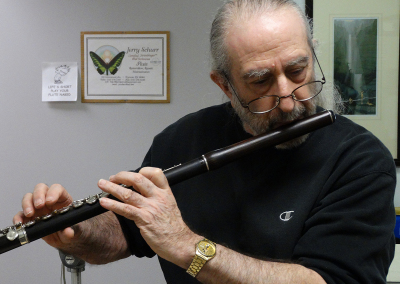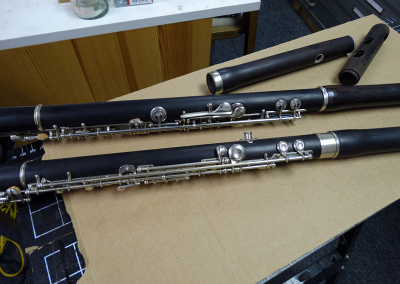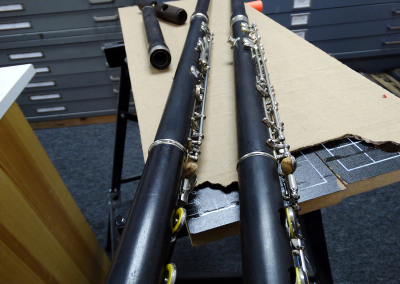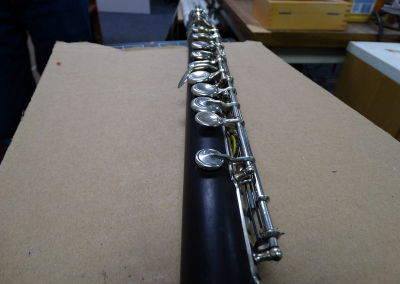THE WOODEN FLUTE AND ITS QUALITIES
Over the last fifteen years I have been involved in the restoration of vintage flutes and in particular wooden flutes, from Baroque through the nineteenth century simple system, culminating in the Boehm sixteen/seventeen key, both closed and open hole examples. There are many questions that I’ve had to answer relating to the art of restoring the above instruments and I’ve decided to compile a list of those questions that have concerned my customers.
Beginning with the early simple six hole flute of the late eighteenth through the early nineteenth century.
Click On The question to see the answer
Is it possible to repair a cracked head-joint, even if the crack is through the embouchure?
2. Can the embouchure hole be repaired if chipped or otherwise damaged?
Are the tenon joints repairable ?
With modern wood restoring techniques most if not all cracks are repairable and will remain stable into the foreseeable future of the instrument.
What is the actual pitch of my flute and can it be altered?
Physically altering the pitch of the early flute can be achieved by either having several head joints of different lengths or changing the length of an existing head joint. Moving the cork stopper is not a pitch changing technique but a method of establishing or improving the intonation of the actual pitch of the flutes individual scale notes.
What are the major wood types used for the early flutes?
In the late eighteenth century the European Boxwood was a preferred flute material due to its hardness and lightweight qualities as well as its lustrous golden grain. It was frequently accompanied by body rings made of several fine materials such as elephant ivory and fine ox-bone. By the turn of the nineteenth century, Brazilian rosewood, cocus wood and grenadilla supplanted the boxwood as the preferred materials. All three of the above are very dense and don’t suffer from the problem of warping as does boxwood.
Can the nineteenth century simple system keyed flutes be made to play well again?
What are the Special characteristics and materials encountered in the above flutes?
- Most have head joints that are accompanied by a tuning barrel for pitch adjustment.
- The crown stopper mechanisms are fully adjustable.
- The keys are either block mounted (early nineteenth century) or post mounted with either friction axles or threaded axles.
- The key-work is generally of nickel silver or sterling with flat springs mounted on the underside of the key lever and in contact with the body of the flute either directly or with a small metal pad.
- The pads are usually soft kid leather and are floated into place using melted shellac.
- The tenons are either thread wrapped or cork wrapped for an airtight seal.
- Off-time the head joint is completely unlined except for the lower tenon joint but as the flute was called on to project over accompaniment instruments the wood was lined with a metal tube. Wood then began to be replaced with more “resonant” materials such as elephant ivory and metals.
- One of the problems that arose due to the metal linings, was the inability of the overlaying organic material to adjust to the rigidity of the lining which resulted in severe cracks developing longitudinally; off-times through the embouchure.
- I’ve developed specialized techniques to deal with and correct the above problems.
What other than the Boehm system flutes are there and do you work on them?
- During the nineteenth and early twentieth century there were many innovations in the evolution of the modern Boehm flute; several co-existed alongside Boehm’s invention and deserved attention by both the players and makers of the time: here is a partial list:
- The Siccama flute
- The Clinton Equisonant flute
- The Pratten Flute
- The 1851 Carte system flute
- The 1867 Carte system flute
- The Radcliff system flute
- The Schwedler flute
- I’ve had the opportunity to work on all the above instruments and I find each both fascinating and unique in their approach to solving the problems of producing the pure essence of sound so significant to the flute.




